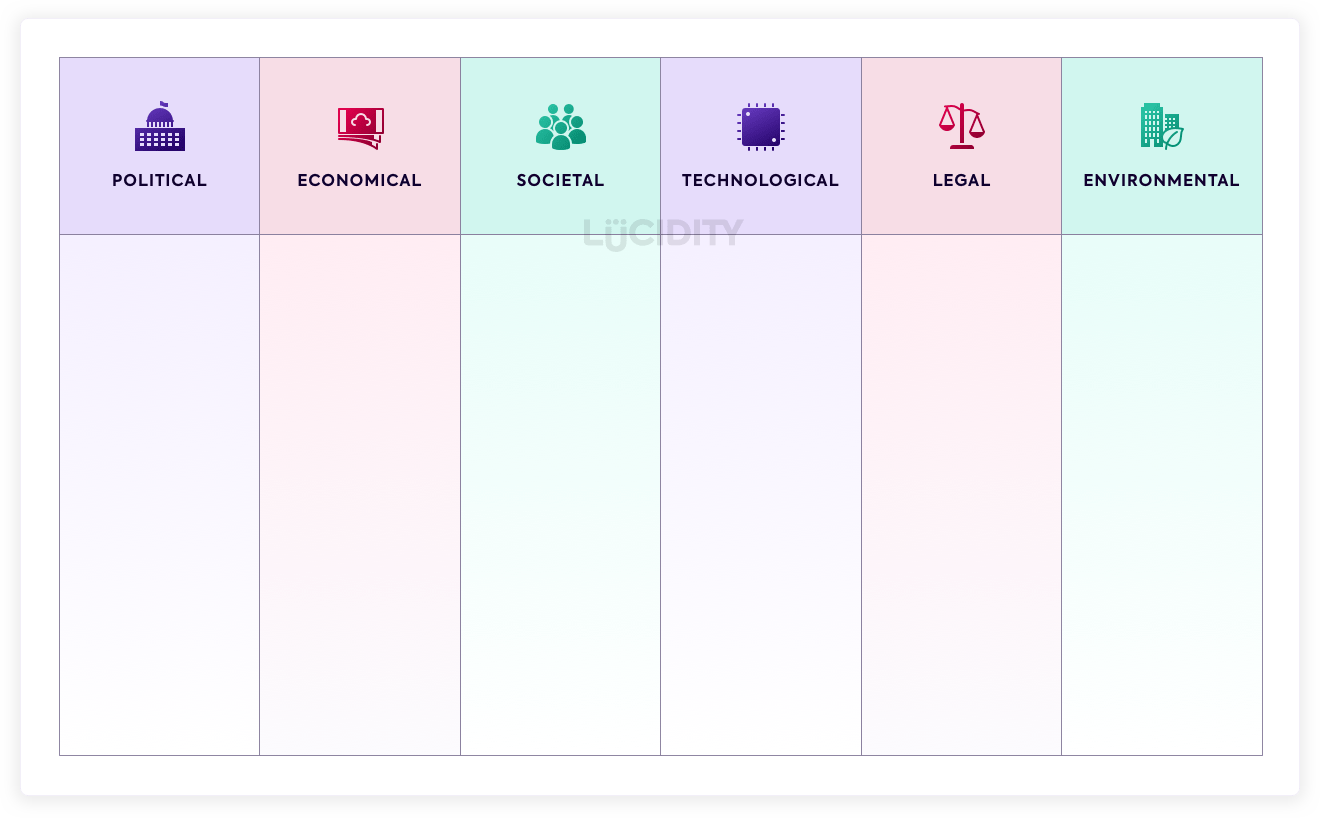We’ve previously said that SWOT Analysis is the salt of strategy, it’s used in most recipes. If that’s the case then it’s fair to say PESTLE is the pepper… they complement each other well and are both found in many good strategies. 🍳
Before we begin, if you’ve not heard of PESTLE before remember to check out our Introduction to PESTLE before you read this guide.
There are a number of pillars to work through with a PESTLE, so you may find that it’s useful to either segment your team into groups who focus on different parts, or tackle each area within a defined period of time.

The hardest part of PESTLE can be defining the scope, so agree with the team if you’re looking at things from a country specific perspective, or if you’re factoring in global considerations. If you consider too many factors at a global level, e.g. a business in the US citing Brexit, you may find the PESTLE becomes too broad.
If you’re having trouble defining scope it may be worth looking at our introduction to LoNGPESTLE.
1 – Political
Governments obviously have a massive impact on numerous industries and businesses. A good way to think about the Political pillar is to list any impact the government may have on your operational day to day business, such as employment law or tax. Once brainstormed, consider what may be happening in the sectors you work within – so if you’re a healthcare technology provider, what healthcare policies will impact you?
Finally, consider the wider political landscape. What are the aspects around stability, international relations or elections that may impact your company?
Place as many as possible because you’ll be refining these later. Make sure you’ve been through your entire business. It can often help to think of your client journey, all the touch points, and your sales messaging during this stage.
Example Generic Political Areas:
- Change of government
- New maternity policy law
- Corporate tax change
- Trade war
Helpful Questions:
- What industries are you or your customers working in?
- When is the next election?
- Is your business international?
Once you’ve devised your Political list it’s time to refine. This involves removing duplicates, making sure you’re as specific as possible, and ensuring that they are accurate.
A good Political pillar will have a defined list, enough to provide the areas that truly need to be considered, but not to the extent of listing every eventuality. Take a step back and evaluate each one, is it really a Political issue that will impact you?
2 – Economic
Economic covers any factor that is around the economy which may impact your business. Recession, interest rates, changes of currency value, etc could all impact you positively and negativity.
Example Generic Economic Areas:
- Interest rate
- Inflation
- Currency value
- Recession
Helpful Questions:
- Are all of your sales in one country?
- What is your current tax footprint?
- What is the forecast for your country’s economic growth?
As with the Political pillar, once you have your list it’s time to refine it. The same rules apply, you want to end up with a manageable, clear list that defines the economic factors which you need to consider when developing your strategy.
3 – Social
The Social pillar looks at the issues relating to the demographics of your customers and can be one of the most important pillars to discuss, especially if you’re a marketing focused business or target one segment of society.
It can include areas like age, growth rate, lifestyle and culture. Consider population and social trends and the differing ways society has developed over the years and you’ll be able to cite examples of where this has impacted business, not just in marketing but also through to areas such as litigation and employment.
Example Generic Social Areas:
- Cultural trends
- Health awareness
- Aspirations
- Working trends
- Behaviour of different ages
Helpful Questions:
- What are the personals your business targets and how are they changing?
- What are the demographics of your employees?
- How may these change in the future?
When done you need to once again go through a process of refinement, as with the Political and Economic pillars.

4 – Technology
This is often the easiest pillar to identify, as it looks at ways technology can impact your business. This space changes the most rapidly compared to others and provides areas that can impact every part of your company, from innovation to operations. You don’t need to be a technology company for this important pillar – think also about how you use technology each day.
Example Generic Technology Areas:
- Device profiles and usage
- R&D products
- Data tools / AI
- Battery technology
- Transport
Helpful Questions:
- What are the current operations in the company and how could technology impact them?
- How are your products or services impacted by the rate of technology change?
- What parts of your company could benefit from automation?
Then it’s time once again for that refinement process! With so much happening in the tech space it can be hard, so keep it focused.
Some people finish at this stage, resulting in a PEST analysis, but if you wish to continue then we move on to the next pillar… ✊
5 – Legal
Legal is very specific, otherwise you’ll find too much overlap with the other pillars. This is about the specific laws that will impact your business, for example GDPR caused significant work for many businesses in the EU, costing many millions. This isn’t about policy or intent, it’s about specific legalities of operating your company.
Example Generic Legal Areas:
- Health & Safety laws
- Digital & Antitrust laws
- Trademark & Patent laws
- Employment laws
Helpful Questions:
- Department by department, what laws influence you day to day?
- Are there new laws coming into effect within the next 12 months?
- Do you have an inhouse lawyer or outsourced service you can ask?
6 – Environmental
A significant amount of discussion is devoted to climate change, the environment we live and operate in, and the impact that has on our business. Weather, climate, green taxes and more will all potentially impact your ability to successfully trade without good planning. Additionally, many companies are responding publicly to the threat of climate change by ensuring green policies and sustainability are covered in their CSP.
In this pillar brainstorm all of the environmental factors that may result in you needing to make changes to your business.
Example Generic Environmental Areas:
- Weather conditions
- Green taxes
- Supply chain and resource availability
- Commodity costs
- Physical risks
Helpful Questions:
- What aspects of your business impact the environment?
- How sustainable are your resources?
- What aspect do employees currently play in your company CSR?
One final refinement and then you’ve got your complete set of pillars.
At this point you have a full PESTLE analysis, giving you a picture of all the external factors that impact your company. Take a step back and review all pillars together, is there anything missing, or have you a complete picture?
Now time for the two bonus steps… 🏃
7 – Taking Action
Quick Wins / Mitigations:
There will be quick wins and mitigations that can be actioned from your PESTLE in your day to day business, to remove or mitigate any threat or take advantage of opportunity. These should be allocated to a manager or employee and actioned.
Long Term:
A PESTLE is part of a wider process, it’s given you a picture external landscape. At Lucidity we’d recommend it’s used in conjunction with other tools as by itself it does not provide you with a full picture in order to successfully plan.
8 – Beyond PESTLE
Your PESTLE analysis can be extended in the following ways:
-
Use as a foundation for future PESTLEs. Each time you come to do your company PESTLE, using your latest one as a template saves time. Each point still needs to be discussed and agreed, and it’ll quickly become apparent if you’ve made progress
-
New product development. PESTLEs can be produced as a way to show changing trends outside of your business and help you react accordingly.
-
Expand your PESTLE to become a LoNGPESTLE
Video Guide on PESTLE
If you’d like to see a summary of the above, check out our PESTLE video below…
We hope you found this guide helpful. To access more content or create your own PESTLE sign up to Lucidity today.












